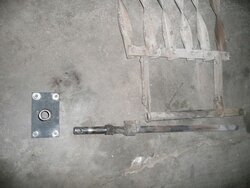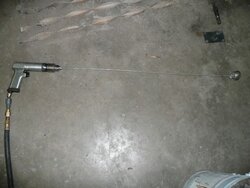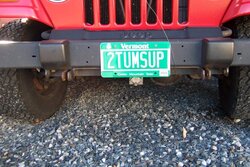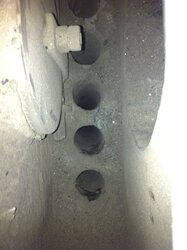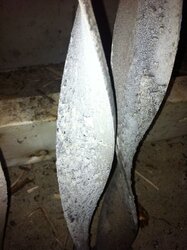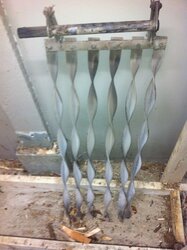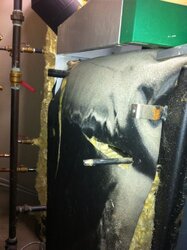And I'm smiling Last Spring, toward the end of the heating season I proclaimed on this forum that I was going to remove all that claptrap that EKO installed to supposedly keep the tubes clean but was mainly a disincentive for frequent cleaning. I did it
Last Spring, toward the end of the heating season I proclaimed on this forum that I was going to remove all that claptrap that EKO installed to supposedly keep the tubes clean but was mainly a disincentive for frequent cleaning. I did it
Slightly less than one cord put thru since October.
Removed the cover and reached in with a hook that snags the 2 1/2 inch ring that I attached to the top of each turb which also keeps them from dropping all the way to the floor of the lower chamber. There was a thin coating of flyash on each turb. (not microscopic). In one or two locations on each turb there was a 1/8 inch or so build-up where the turb contacts the tube. Sorry, no photo. Thought about it but you wouldn't have been able to decypher what I was seeing. Two swipes with the wire brush in each tube and the third swipe produced almost no dust. Took the turbs outside brushed them with a soft bristle brush and reinstalled. Now what am I going to do with all the extra time I had allotted to the job?
 Last Spring, toward the end of the heating season I proclaimed on this forum that I was going to remove all that claptrap that EKO installed to supposedly keep the tubes clean but was mainly a disincentive for frequent cleaning. I did it
Last Spring, toward the end of the heating season I proclaimed on this forum that I was going to remove all that claptrap that EKO installed to supposedly keep the tubes clean but was mainly a disincentive for frequent cleaning. I did it
Slightly less than one cord put thru since October.
Removed the cover and reached in with a hook that snags the 2 1/2 inch ring that I attached to the top of each turb which also keeps them from dropping all the way to the floor of the lower chamber. There was a thin coating of flyash on each turb. (not microscopic). In one or two locations on each turb there was a 1/8 inch or so build-up where the turb contacts the tube. Sorry, no photo. Thought about it but you wouldn't have been able to decypher what I was seeing. Two swipes with the wire brush in each tube and the third swipe produced almost no dust. Took the turbs outside brushed them with a soft bristle brush and reinstalled. Now what am I going to do with all the extra time I had allotted to the job?



